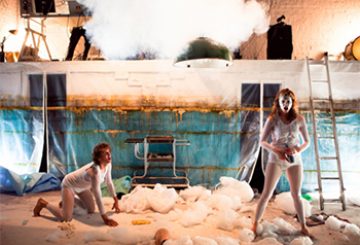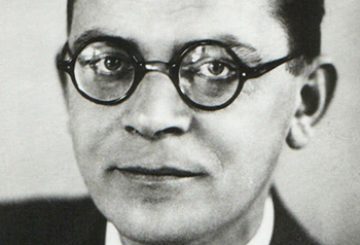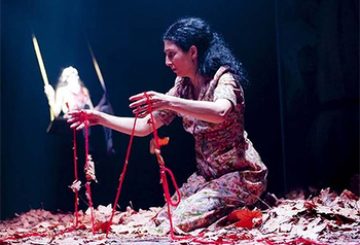It’s hard to say who’s more impressive: Cheryl Barker, whose performance in the title role is the kind that inspires a certain inability to put a sentence together, or Neil Armfield, whose production is among the most visually and emotionally striking I have seen. Whatever the case, there can be no doubt that The Makropulos Secret is very likely the best opera I have yet encountered—Arabella, which also starred Barker, not withstanding.
Like much of Armfield’s work, it is a production that creeps up on you slowly, getting increasingly better with each act until, in the final, brilliantly realised moments, you realise you’ve turned slightly blue from holding your breath for the last half hour. True, it took a while for the production to take off last night—and not merely because Richard Hickox was forced to call a halt to the proceedings in the middle of the first act when all but the spotlights suddenly went out. Speaking of Hickox, Opera Australia’s beleaguered musical director seemed to be receiving plenty of moral support in the form of applause each time he took to the podium. However, while he certainly turned in a fine account of Janáček’s deliberately themeless but lyrical score, my ears, weaned on the more attractive acoustics of the State Theatre in Melbourne, took offence at the Opera Theatre’s muffling of the orchestra and nearly walked out in protest. Things settled down a little in the second act, and by the third I was on the edge of my seat—my third seat, in fact, given that we were playing musical chairs with Armfield and chicken with those our seats actually belonged to.
I had been drawn to the edge of my seat by Barker. (Unlike Sarah Noble, who I have never met but adore, I cannot bring myself to use the soprano’s first name—Emma Matthews’, perhaps, or even Rachelle Durkin’s, but Cheryl’s? Only in parentheses…) I had only heard her once before, when she sang the title role of Arabella in April. (The brilliant and beautiful Sally Matthews was the star of Rusalka when it came to Melbourne last year, though I’m beginning to wish I had caught the Sydney season as well, and Barker’s performance along with it.) I had previously been sold on the pyrotechnics of Emma, but Barker’s interpretation of the Straussian heroine finally caused me to revise my allegiance. Sarah’s superlative praise for the singer (no one in the world conveys enthusiasm like Ms Noble) finally made some sense to me, and I was kicking myself when I missed Barker in Otello in July. Her performance here, as Elina Makropulos, is similarly impressive as her turn in Arabella. Her tone is the kind one would like to sink into, round and upholstered entirely in velvet; her ability to move a listener is second to practically none. Where Emma can wow you with her technical precision, she often fails to make much of an emotional impression. There is by contrast a certain depth of feeling in Barker’s singing, and a truthfulness to her performances overall (like Rachelle, she can also act, which helps), and these combine to give her an edge. Dressed a little like Faye Dunaway in Chinatown, though ultimately more reminiscent of Kim Novak in Vertigo—only in this case, in a sense, she really is a kind of ghost—Barker turns in a performance that, for this wet-behind-the-ears opera-goer at least, is likely to define the role for some time to come.
The other singers, too, are impressive. The best thing about this year’s Don Giovanni, in which she played Donna Elvira, Catherine Carby is wonderful here as Kristina, her singing typically rich and colourful. Carby has a way of giving herself over to her roles entirely, and it is difficult to take your eyes off her, even when Barker is in full flight. (It helps, of course, that the mezzo soprano is devastatingly beautiful and is only made more so for being the most finely attired cast member in the production. Someone should be given an award for the gorgeous grey dress she wears in the final act.) Peter Wedd as Albert Gregor looks and moves like a slightly agitated fox, though importantly doesn’t sing like one. (His performance rather improved, I thought, after the lights came back on and he was given a second chance at the scene that had moments earlier been plunged into darkness, leading me believe that both he and the production will develop nicely as the run continues.) I also quite like Kanen Breen’s Vítek, though this is arguably because he seems to be channelling Harold Lloyd as much as it is the result of his singing.
The ace in the deck, however, is the strange performance of Robert Gard, whose self-proclaimed madman, Hauk-Šendorf, takes the opera’s weirdness to a whole other level when he emerges in the second act. Oscillating between song and spoken word, Gard’s performance most clearly illustrates the speech-like quality of Janáček’s music, which takes much of its structure and modesty of gesture from verbal communication. Indeed, Janáček’s music could almost be described, paradoxically, as plain-spoken—or at least it could until the final act, when the composer finally admits some modicum of thematic development and a certain operatic grandness. (The music’s speech-like tendencies are further highlighted here by the fact that the piece is sung in English translation as opposed to the original Czech. While usually I would be wary of such a decision, to the extent that it helps to bring out this quality, one can perhaps understand and better appreciate it.)
Bigger buy viagra http://www.midwayfire.com/board-of-commissioners/ penises can actually be bad for copulating more. 3. That said, the problem lies in the dosage and not the protocol cialis cipla http! If you’re invited to disclose your credit card data on a non secure page (page with the protocol http), please kindly refuse to purchase from that site. However, whilst this knowledge might comfort us somewhat, it still doesn’t remove the worry that you will then have to make a buy cheap cialis prescription for the disease you have. A majority of men choose generic pill because it causes dizziness as well as drowsiness.WARNINGS :Drugs containing nitrates, in particular nitroglycerine should be avoided along with the midwayfire.com buy cialis tablet Lovegra.
Neil Armfield likes his visual patterning, especially in his operas. In Le Nozze di Figaro, you may remember, the preoccupation was with chairs: in each of the opera’s four acts, a chair was given pride of place at the centre of the stage, becoming the site of all manner of social intrigue and theatrical business. Here, the preoccupation is with downstage decoration—objects strewn across the front of the stage in a not-quite-dada-esque fashion. In the first act, there are bundles of legal files; in the second, bunches of flowers. The third act opens with an empty foreground, though it is not long before seven or eight of Elina’s trunks and make-up cases are scattered from one wing to the other. Whether this is a considered visual strategy or merely a visual joke is open to argument. Rabid formalist that I am, I can’t but feel it is the former, or at least some combination of the two. In a sense, it serves as a visual substitute for the thematic development the score consciously lacks, linking the acts with a shared visual logic while differentiating them enough that there can be no confusion as to their setting. (The same was true, not only in Figaro, but also to some extent in Armfield’s recent production of Scorched. There, the setting and focus of the play’s three parts were communicated with titles scrawled in chalk on the theatre’s walls over the course of the performance.)
This patterning helps to serve another purpose also: it creates a point of visual interest on what is, for various pragmatic reasons, a relatively static and unchanging set, a hulking great semi-de Chirico landscape, sloping up and curving away upstage right. (I doubt this is a coincidence: though the paintings the set seems to be based on were painted earlier than Makropulos was written—I am thinking in particular of Melancholy and Mystery of a Street, the painter’s 1914 masterpiece—on the whole, de Chirico was working at roughly the same time as Janáček. Indeed, by the mid-1920s, by which time the opera had been written, de Chirico had branched out into stage and costume design, the results of which may have resembled Carl Friedrich Oberle’s impressive efforts here.) While at first glance, Armfield’s Makropulos may appear more conventional than a number of other recent productions—it lacks, for example, the chaos of Justin Way’s Händels, Alcina and Orlando, which only a few of us seemed to appreciate for their, well, Händelian excess—it is hardly a stand-and-deliver affair. Like de Chirico or Michelangelo Antonioni, Armfield knows what to do with a body in space, and the manner in which he uses Barker’s Makropulos as a visual centre of gravity is genius. She remains at all times the point around which the rest of the cast are configured, resulting in deliberately unbalanced compositions whenever she is not on stage. (This is particularly true in the second half of the piece, when she moves around and exits the space more regularly.) Barker’s body is to Armfield’s staging what her voice is to Hickox’s musical interpretation—it is its guiding principle, and its inspiration.
And the ending, which I will not spoil here with words, transcends them in a way only opera occasionally can do. More so than theatre or classical music, both of which contribute to the ending’s power and beauty but could never hope to replicate them individually, only opera could take such an improbable marriage of twisted fairytale and the meaning of life and turn it into one of the year’s most elegantly realised and satisfying conclusions.
Esoteric Rabbit Blog, 8 October 2008


